How to spring clean your stock tank container pond
A few years ago I wrote a post explaining how to make a container pond in a stock tank, and many readers have since written to tell me they’ve made their own ponds by following my instructions. I also get a lot of questions about how to take care of a stock-tank pond throughout the year, so last fall I wrote a follow-up post about winterizing my pond, and today I’ll show you how to clean a stock-tank pond in preparation for summer. Keep in mind that all my pond information is relevant for zone 8b; those of you in colder climates should consult a local pond expert for more information.
The picture above shows just how ugly my stock-tank pond looked last weekend, after a few winter freezes and the big leaf drop that happens in mid-March as the live oaks shed their old leaves. Not pretty! With freezing temps behind us and summer right around the corner, it was time to clean the pond.
First I put on old clothes that I didn’t mind getting muddy. Next I unplugged the pump that runs the spigot fountain. Then I reached in and pulled out all the plants. Have I mentioned that pond plants grow like they’re on steroids? This is my ‘Colorado’ water lily after a season of growth. It’s grown right out of its plastic container and produced an entirely new plant, connected to the old one, outside the pot. Look carefully on the lower right, and you’ll see the rim of the black plastic pot. The mass in my hands is the new, unrooted lily.
Once all the pond plants are out of the pond (place them under wet newspapers in the shade if the day is hot; they should not be allowed to dry out), use a sturdy net to clean the surface of the pond of leaves, rotted plant material, and other debris. Then sweep the bottom of the pond with the net, lifting out decomposing plant matter and putting it in the compost pile. Be careful not to scoop up or accidentally discard your fish. Once you start netting the bottom of the pond, the water will get cloudy with silt, so you’ll need to examine your net carefully each time you dump it out. Alternatively, you could net your fish and put them in a clean tank filled with pond water while you clean, but I never do this and still end up with what seems like all my fish.
Once the pond is mucked out, it’s time to divide the plants. Pond plants need dividing every year because of their aggressive growth. The nice thing about this is that you can furnish your pond-loving friends with divisions each year. Of course, next year they’ll be looking for someone to give their divisions to as well.
If you can slip or shake your plant loose from the plastic pot, great. Sometimes, however, the plant just won’t budge. In that case, I use a hatchet to split the side of the pot, cutting the plant loose and exposing a very root-bound plant.
Then I use the hatchet to cut through the root-bound plant, dividing it in half. You could also use a plant saw to divide the plant, and maybe that would be safer than a hatchet. I am quite careful about where I swing that blade.
The hatchet goes through all that mess as if it were soft butter.
Here I’m dividing a slightly less messy ‘Helvola’ water lily. Make sure you divide so that you see stems and roots in each piece.
Chop, chop. I got three divisions out of this one.
Place your divisions, ideally, in solid, plastic pond pots with no drainage holes. However, if, like me, you neglected to buy enough pond pots, you can use regular nursery pots. The plant will probably send roots out through the drainage holes, but since the pot sits in a metal tank, the plant can’t really escape anywhere.
You’ll need to fill in around the divisions with soil. Pond plants like to be planted in heavy clay. Don’t use regular bagged potting soil, which is too light and will float out of the pot. I just go out in the garden and dig up some clayey soil, of which I have plenty, to fill in my pots. If you don’t have clay soil in your yard, heavy potting soil can be purchased at pond stores. Hill Country Water Gardens in Cedar Park, for example, sells a 50-lb. bag for $5. I’m sure you don’t douse your lawn or garden with chemical fertilizers or pesticides, but if so, you shouldn’t use that soil in your pond.
Here’s a ‘Helvola’ division all potted up with lots of growing room. Next step: top your plant pots with a layer of clean gravel to help keep fish from nibbling the plant down to nothing and to keep mud from clouding your water. I press one fertilizer tab for pond plants into each of my new divisions and then place them back in the pond. Water lilies go on the bottom of the tank; marginal or bog plants go on top of overturned pots or piles of bricks so that they sit near the surface.
The final step is to purchase new underwater cleaner plants, which are essential for keeping your pond free of algae in the summer. I use 8 bundles of anacharis in my 700-gallon pond. Place the bundled anacharis stems in pots of clean gravel (no need for soil) on the bottom of the pond. The gravel holds the bundles in place.
Take this opportunity to clean out the filter in your pond pump. Remind yourself that you really should stay more on top of cleaning your pump’s filter. Then put it back in the pond and plug it in.
Voila! Your pond is clean and ready for summer. Enjoy!
This is part 3 of a 3-part pond series:
Part 1 — How to make a container pond in a stock tank
Part 2 — Winterizing a stock tank pond
Part 3 — How to spring clean your stock tank container pond
All material © 2006-2013 by Pam Penick for Digging. Unauthorized reproduction prohibited.


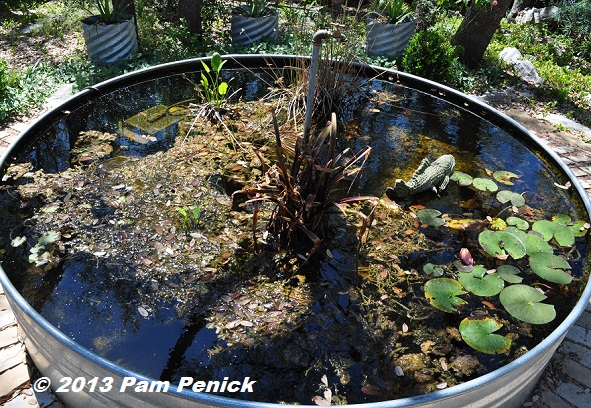
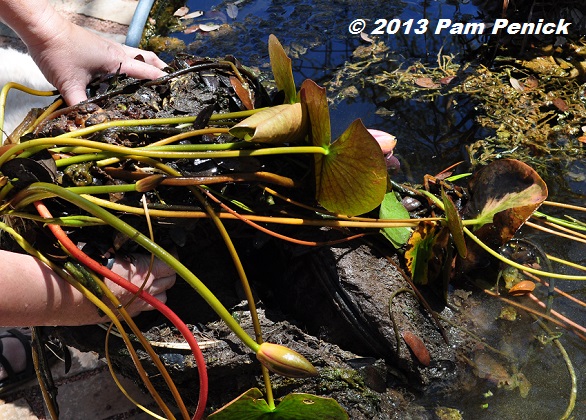
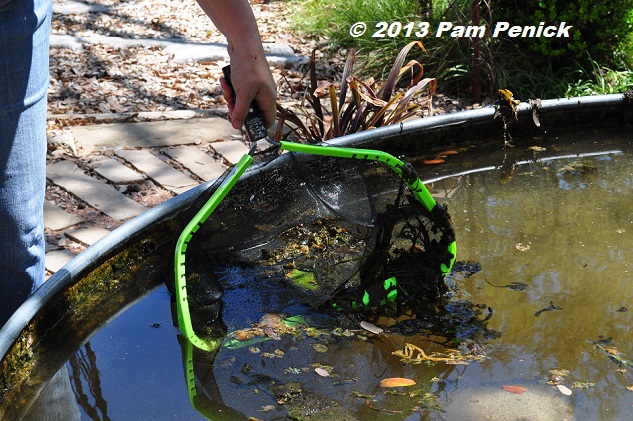
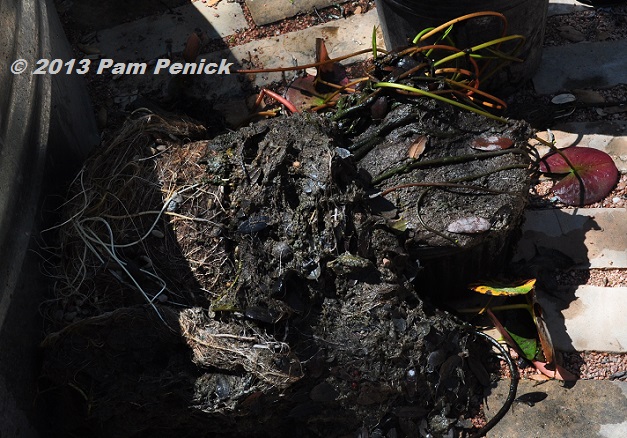
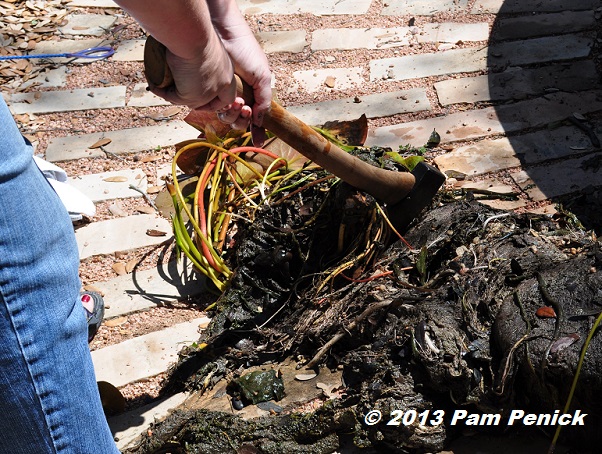
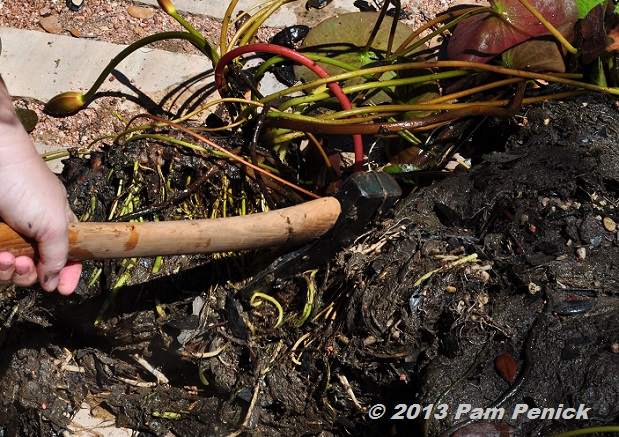
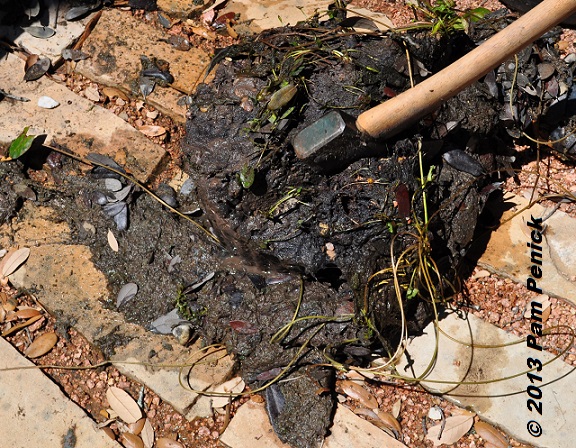
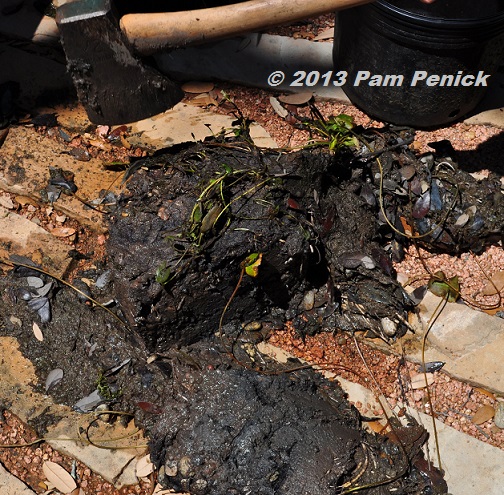
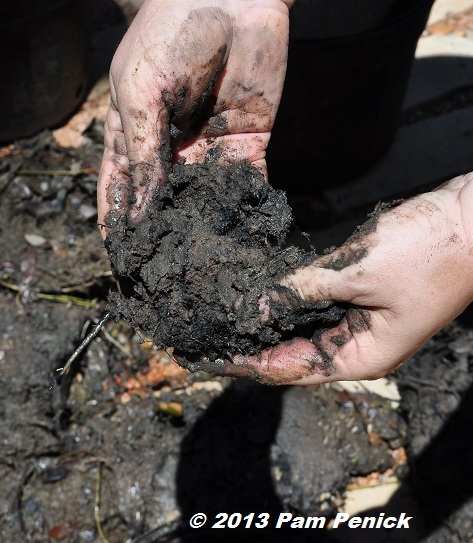
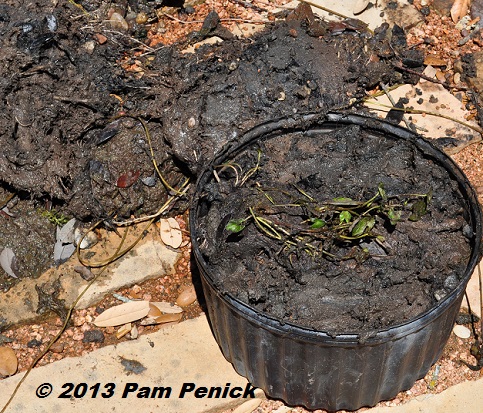
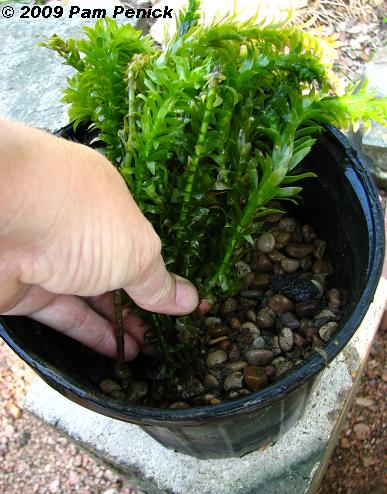
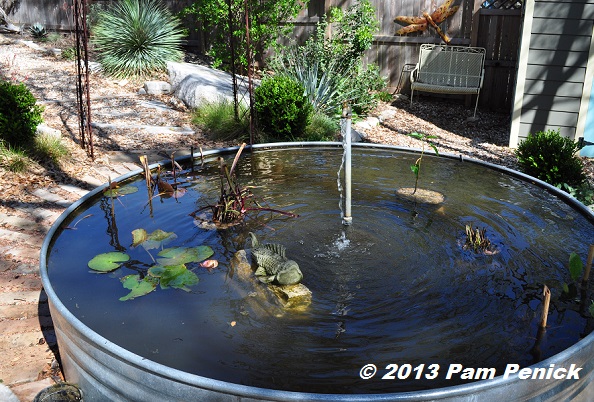
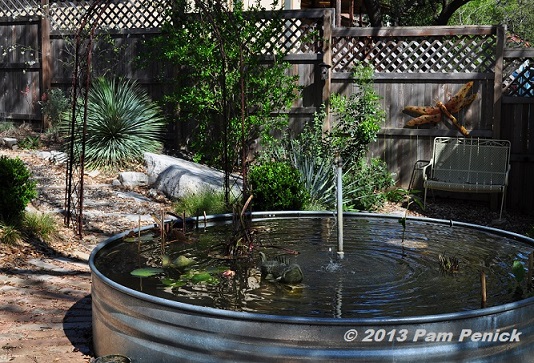
Last fall was the first year I still had fish. Previous years birds took them all. I live in 6b so I got a small stock tank heater and unplugged the pump for the winter. I used shade cloth to make a cover to keep debris out. The water was pretty murky the last time I checked. I replaced half the water in January. I even took two marginal plants into the garage to see if they’d come back in the spring. We’re looking to buy our first home and I can’t wait to get a 700 gallon round tank like yours. Right now I have a 2×3 and a 2×5. We had quite a problem with raccoons for the first time last summer.
Herons and raccoons can be pond pests, for sure. If they keep after your fishy friends, just remember that while fish are part of the fun of a pond, you can still have one without so long as you use mosquito dunks. —Pam
Pam, you inspired me a few years ago to create my stock tank pond, so thanks for sharing your expertise & creative ideas!
I would highly recommend using rubber or latex gloves. This is a messy job & my hands & nails were stained for weeks after dividing my water lilies last year. I read (after the fact) that some species of water lilies can stain hands & mine sure did!
It was funny when I began the division project I thought it would be a delicate process, but it took all my strength to haul out 2 buckets of water lilies whose roots had grown together & then to divide them I had to use a machete!
I found it helpful to have a small child’s swimming pool on hand filled with water to place the uprooted lilies in temporarily while I was working on the pond.
Great tips about using a baby pool and gloves, Linda. Thanks for sharing your expertise too! —Pam
I like the swimming pool idea. I have a couple of black concrete mixing trays that I use as all-around handy pots and they are my staging area for the pond plants.
I don’t do the full cleanup every year. This means when I do get to it, I’m using a pruning saw to divide my umbrella plants. They spread super fast, but are fail proof, so I love them. (when I was in Michigan, I’d overwinter these in a 5 gal bucket under a bright window. They never faltered. Great plants for beginners!)
Helvola is on my ‘look for’ list. Is there anything I might have that you’d like to trade for? I’ve got a couple of nice small scale agaves pupping right now that might work on your succulent wall. Blue and very spikey dramatic!
Jenn, if I had any idea how to ship a water plant to Arizona I’d be glad to share. Sounds tricky though. —Pam
I buy some anacharis once a year, too. The fish eat mine almost as soon as I put it in, but first it takes care of the annual onset of green water. Almost miraculous, how quick this works!
Those fish are hungry when they “wake up” in spring. But yes, the underwater plants do work miracles. —Pam
Thanks for the info. Our zone 5 cedar-framed, above-ground pond is still in the winter phase. But the transition to spring is coming fast. I’ll incorporate some of your universal suggestions into our spring clean-up in the coming weeks. Cheers!
Have fun mucking the pond, PP! (Pick a warm day.) —Pam
She doesn’t wear gloves and uses a hatchet! You are a tough one Pam!
Did you notice I was wearing sandals while wielding the hatchet? I tried to crop that view out. For safety’s sake, I encourage people to do as I say, not as I do! —Pam
That looks kind of yucky I must admit, Pam – BUT…I still want a pond 😉 Man, how long did that take you?
I enlisted my daughter to help me muck out the pond, Heather, and after that she was mainly my gopher, running inside to get towels or tools as needed and taking pictures for this post. I’d say we spent about 2 hours on the spring cleaning. —Pam
We do the same for our waterfall/stream water feature, but use a much bigger pump that we also use to pump water off our swimming pool cover. There are so many bullfrogs that take up residence (invasive critters and not native), so we let our stream sit for a few days after pumping out to encourage the frogs to move out. I couldn’t believe how the Louisiana iris roots had grown beneath big rocks and sprouted on the other side! It was a huge task to divide the irises!
Wow, monster iris and bullfrogs! Sounds like an adventure cleaning out your waterfall and stream, Freda. —Pam
How you manage to muck out the pond and still have energy left to post about it is beyond me! You’re amazing.
I’d been meaning to post about this process for a while, Vicki, and I got my daughter to help me with the photo taking (I was way too muddy to do it). I slept well the night after the cleaning and posted the next day. Now I’ve checked that off my list! Have I ever told you how motivated I am to check things off my lists? —Pam
Thanks for all this information, still considering a stock tank pond so the more info the better.
My pleasure, Shirley. Keep in mind that the big clean-out is only once a year. The rest of the year the pond brings a lot of pleasure and beauty to the garden. —Pam
Blog looks great! We have not divided our pond plants for the last 2 or 3 years! Now we are dreading doing it this spring. But they were so massive they really put on a show. Still lots of snow on the ground here. Snowdrops just beginning to pop up. A very last Spring!
Ooh, after 3 years of growth, I can’t imagine how you’ll even haul those overgrown pond plants out of the pond! Oh, nevermind, I just remembered that you and Mark can do just about anything, and make just about anything, in the garden. Hope you get some spring weather soon so you can start mucking. —Pam
Here in Tucson we use plain kitty litter as a planting medium for our pond plants. It’s a good lightweight clay, and still pretty cheap. Just make sure it is plain clay litter, with no additives, which is getting harder to find. My source is Safeway, if you have it in your town.
Also, I line the bottom of the pots with coffee filters to keep the planting medium, and roots in.
ps, my grandfather was a Penick, whose relatives moved to Austin in the 1870’s. Maybe we’re related, but I hear there are a lot of Penicks in Austin.
Kitty litter? How interesting! Good tip—thanks for sharing, HL. Yes, there are quite a few Penicks in Austin. My husband’s relatives moved here from South Carolina and Mississippi though. —Pam
I am seriously considering creating a water feature in my garden this year so the information is really useful. I especially appreciated the photos.
Have fun making your own container pond, Charlie! —Pam
How long do you think a stock tank like that will last? Is it stainless steel? It is pretty cool looking.
It’s galvanized steel, Kaveh. I don’t know what the life expectancy is before it starts to rust through—maybe 10 or 15 years? —Pam
I use a plastic tank. It’s like the hard/rubbery type plastic, just not sure what the exact name is for it. I bought it my local Co-op for around $300 and it’s a 700 gal. It works great. It even has drain plug on it to make changing water easy.
I always hate to clean my ponds because of all the critters I know I’m killing; most especially dragon fly larvae that have over-wintered.
I didn’t know dragonfly larvae overwintered, Meg. Bummer. —Pam
@Kaveh-
I am still (steel? LOL!) using the 3 stock tanks I purchased (specifically to make ponds)in 1995; they’re holding up wonderfully! However, I purchased three additional ones in 2009 and they are already showing small rust spots on the outside. They weigh a lot less than the old ones, too, so before I make my next purchase I’m going to make SURE of the quality, and not just make the purchase because it was easily available locally. I’m actually thinking of getting another one and having a “Rhino”-type liner sprayed in, to see if that helps it last!
@Pam-It normally takes me 3-4 days to clean my tank because I literally take small net-fulls at a time and sift through each one (sort of like panning for gold) to recover critters and put them back in. I clean two tanks a year, and throw the dragonfly larvae and snails into the old tanks. I am going to see if I can make an easy-to-handle cover net to install before I mow on windy days, or as autumn arrives.
The biggest challenge for me are aquatic weeds of various kinds. The worst one I have was brought in when I purchased a water lily from one of the Pond stores here in Dallas. Bad form!
I also put a stack of decent sized rocks (probably 25lbs each; the stack has a footprint about 1’x 2′ and each rock is about 4-8″ thick) inside and at the edge of the pond so if an animal falls in, it can climb out. I’ve had birds, squirrels, rats, toads, frogs, and a dog fall in. I normally put a naturally-wedge-shaped stone on top, and birds use the gradient (or the next rock down) to stand on so they can get drinks and bathe, even if the water level dips.
Great information, Meg! Thanks for sharing your experience with container ponds here. —Pam